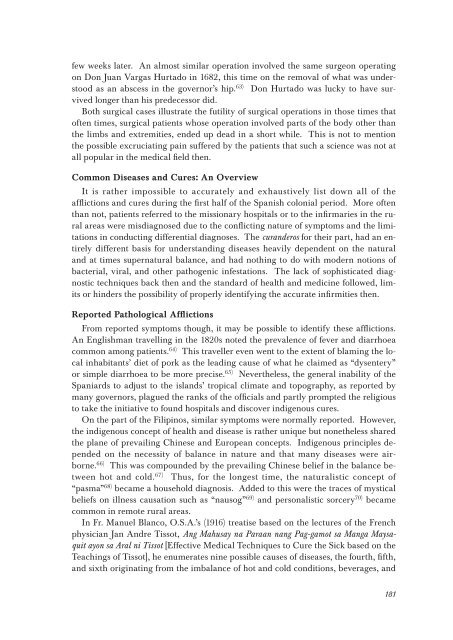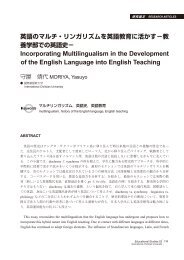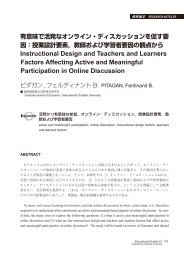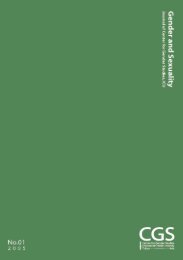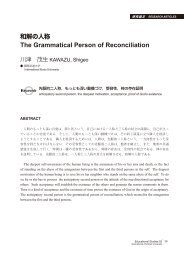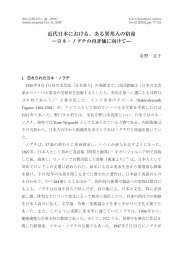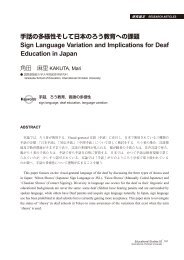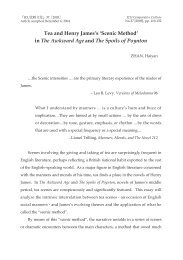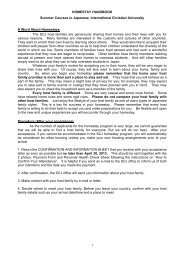Colonial Adaptations in Tropical Asia: Spanish Medicine ... - icu.ac.jp
Colonial Adaptations in Tropical Asia: Spanish Medicine ... - icu.ac.jp
Colonial Adaptations in Tropical Asia: Spanish Medicine ... - icu.ac.jp
You also want an ePaper? Increase the reach of your titles
YUMPU automatically turns print PDFs into web optimized ePapers that Google loves.
few weeks later. An almost similar operation <strong>in</strong>volved the same surgeon operat<strong>in</strong>g<br />
on Don Juan Vargas Hurtado <strong>in</strong> 1682, this time on the removal of what was understood<br />
as an abscess <strong>in</strong> the governor’s hip. 63) Don Hurtado was lucky to have survived<br />
longer than his predecessor did.<br />
Both surgical cases illustrate the futility of surgical operations <strong>in</strong> those times that<br />
often times, surgical patients whose operation <strong>in</strong>volved parts of the body other than<br />
the limbs and extremities, ended up dead <strong>in</strong> a short while. This is not to mention<br />
the possible excruciat<strong>in</strong>g pa<strong>in</strong> suffered by the patients that such a science was not at<br />
all popular <strong>in</strong> the medical field then.<br />
Common Diseases and Cures: An Overview<br />
It is rather impossible to accurately and exhaustively list down all of the<br />
afflictions and cures dur<strong>in</strong>g the first half of the <strong>Spanish</strong> colonial period. More often<br />
than not, patients referred to the missionary hospitals or to the <strong>in</strong>firmaries <strong>in</strong> the rural<br />
areas were misdiagnosed due to the conflict<strong>in</strong>g nature of symptoms and the limitations<br />
<strong>in</strong> conduct<strong>in</strong>g differential diagnoses. The curanderos for their part, had an entirely<br />
different basis for understand<strong>in</strong>g diseases heavily dependent on the natural<br />
and at times supernatural balance, and had noth<strong>in</strong>g to do with modern notions of<br />
bacterial, viral, and other pathogenic <strong>in</strong>festations. The lack of sophisticated diagnostic<br />
techniques back then and the standard of health and medic<strong>in</strong>e followed, limits<br />
or h<strong>in</strong>ders the possibility of properly identify<strong>in</strong>g the accurate <strong>in</strong>firmities then.<br />
Reported Pathological Afflictions<br />
From reported symptoms though, it may be possible to identify these afflictions.<br />
An Englishman travell<strong>in</strong>g <strong>in</strong> the 1820s noted the prevalence of fever and diarrhoea<br />
common among patients. 64) This traveller even went to the extent of blam<strong>in</strong>g the local<br />
<strong>in</strong>habitants’ diet of pork as the lead<strong>in</strong>g cause of what he claimed as “dysentery”<br />
or simple diarrhoea to be more precise. 65) Nevertheless, the general <strong>in</strong>ability of the<br />
Spaniards to adjust to the islands’ tropical climate and topography, as reported by<br />
many governors, plagued the ranks of the officials and partly prompted the religious<br />
to take the <strong>in</strong>itiative to found hospitals and discover <strong>in</strong>digenous cures.<br />
On the part of the Filip<strong>in</strong>os, similar symptoms were normally reported. However,<br />
the <strong>in</strong>digenous concept of health and disease is rather unique but nonetheless shared<br />
the plane of prevail<strong>in</strong>g Ch<strong>in</strong>ese and European concepts. Indigenous pr<strong>in</strong>ciples depended<br />
on the necessity of balance <strong>in</strong> nature and that many diseases were airborne.<br />
66) This was compounded by the prevail<strong>in</strong>g Ch<strong>in</strong>ese belief <strong>in</strong> the balance between<br />
hot and cold. 67) Thus, for the longest time, the naturalistic concept of<br />
“pasma” 68) became a household diagnosis. Added to this were the traces of mystical<br />
beliefs on illness causation such as “nausog” 69) and personalistic sorcery 70) became<br />
common <strong>in</strong> remote rural areas.<br />
In Fr. Manuel Blanco, O.S.A.’s (1916) treatise based on the lectures of the French<br />
physician Jan Andre Tissot, Ang Mahusay na Paraan nang Pag-gamot sa Manga Maysaquit<br />
ayon sa Aral ni Tissot [Effective Medical Techniques to Cure the Sick based on the<br />
Teach<strong>in</strong>gs of Tissot], he enumerates n<strong>in</strong>e possible causes of diseases, the fourth, fifth,<br />
and sixth orig<strong>in</strong>at<strong>in</strong>g from the imbalance of hot and cold conditions, beverages, and<br />
181


